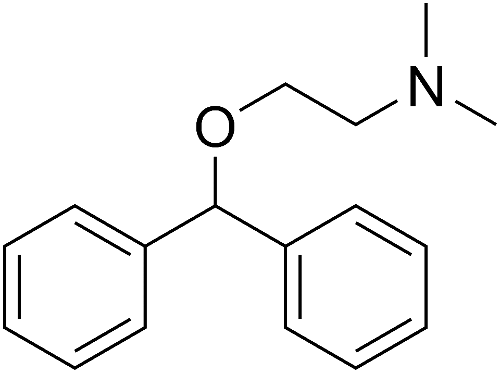Diphenhydramine
Diphenhydramine (DPH, also sold as Benadryl) is an antihistamine with anticholinergic and sedative effects. It is found in both OTC and prescription drugs used in the treatment of allergy-related symptoms, some cold and flu symptoms, insomnia, motion sickness and Parkinson's disease. It has also been researched for many other medicinal uses, including the treatment of OCD.
It has also seen recreational use as a depressant or deliriant drug, with high doses inducing vivid hallucinations which users are often unable to distinguish from reality. Most recreational users find the drug causes a negative experience, due to the profusely negative experience it tends to provide - along with the large amount of negative physical side-effects.
History
DPH was first discovered in 1943 in the USA during a research project fielded around relieving muscle spasms - and in 1946 it became the first prescription antihistamine approved in the USA - therefore, it is known as a 'first generation antihistamine.'
In the 1960s, it was discovered that DPH inhibited the reuptake of serotonin, which, through research of chemicals with similar actions causing less side-effects, led to the development of the antidepressant class SSRIs which are still in heavy use today.
In the 1980s, the drug became approved for over-the-counter use as a sleep-aid (due to its sedative effect) and antihistamine.
Dosage
Overdoses of DPH may cause seizures, coma and ultimately an acute overdose of DPH can be fatal through cardiovascular collapse - though the threshold for this type of reaction is relatively unknown.
Oral
DPH is primarily taken orally.
Therapeutic (insomnia): 50mg
Light: 150-300mg
Common: 250-500mg
Strong: 450-700mg
Heavy: 650-800mg+
Duration
Onset: 60-120 minutes Duration: 6-8 hours
After-effects: 24 hours
Effects
Though DPH causes hallucinations and distortions in the perception, which are often effects sought by the recreational users of psychedelics, these effects are often negative in nature due to the deliriant nature of the chemical and experience.
Positive
- Increased awareness and appreciation of music
- Dream-like experiences
- Vivid hallucinations
- Muscle relaxation
Neutral
- Visual distortions
- Sound distortions
Negative
- Dry mouth
- Delirium
- Confusion
- Muscle cramps
- Nausea
- Loss of coordination (ataxia)
- Increased heart rate
- Photophobia
- Flushed skin
- Itching
- Heart palpitations
- Tremors
- Vomiting
- Stomach pain
- Dysphoria
Chemistry and Pharmacology

Chemical name: 2-(diphenylmethoxy)-N,N-dimethylethanamine
Diphenhydramine is an inverse agonist of the histamine H1 receptor. It is a member of the ethanolamine class of antihistaminergic agents. By reversing the effects of histamine on the capillaries, it can reduce the intensity of allergic symptoms. Diphenhydramine also crosses the blood–brain barrier and antagonizes the H1 receptors centrally. Its effects on central H1receptors cause drowsiness.
Harm Reduction
- Many oral diphenhydramine preparations contain analgesics such as acetaminophen/paracetamol or aspirin, which can be toxic to the liver in high doses. Some adulterants, such as paracetamol, can be removed by Cold Water Extraction.
- Do not combine DPH with any other depressant drugs.